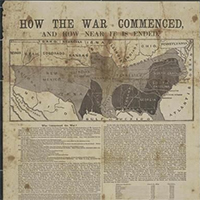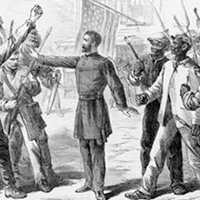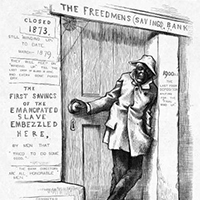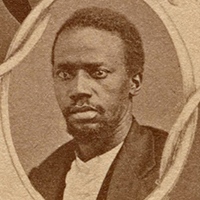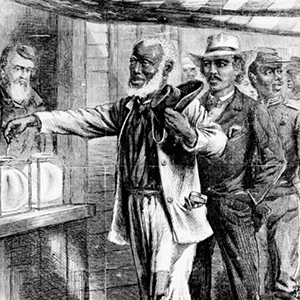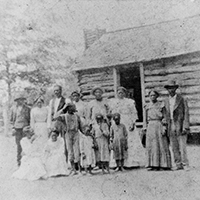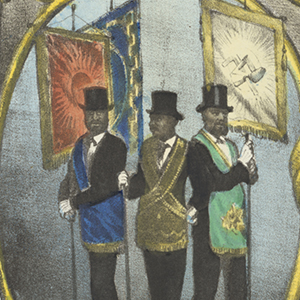Students will know how to use social studies terminology correctly. Vocabulary includes terms, key people, and events of the Reconstructon period.
THIS UNIT
Browse unit contents using the tabs to the right or the filters below.
Share
Tell other teachers, parents, and students about us.
Follow
Pacing
Note: This Unit, created in 2022, will soon be updated to align with our newer materials. Projected Availability: Late October to Early November, 2025.
Contents
Era Overview
When the Civil War ended, the 13th Amendment to the U.S. Constitution outlawed slavery in Texas. Yet three far-reaching questions still had to be answered, and the struggles over these questions would define Texas during the period of Reconstruction (1865-1876).
First, what would become of the newly freed 230,000 African Americans in Texas? They were no longer enslaved, but were they to become citizens or perhaps something else? Second, what was to become of the ex-Confederates in Texas who had waged war against the United States? Were they to regain their citizenship or perhaps take on a different status? Third, how would the United States restore states like Texas to the American Union? Was Texas to regain its full political representation immediately after the war, or would there be punishment for having rebelled against the United States?
During the first part of Reconstruction, commonly called “Presidential Reconstruction,” President Andrew Johnson attempted to answer these questions. Johnson promised that states like Texas could rejoin the Union simply by ratifying the 13th Amendment, he offered a pardon to nearly all ex-Confederates so they could regain their citizenship, and he left the status of African Americans to be decided by their former masters. Anglo-Texans, as a result, quickly passed laws that denied citizenship rights to the former slaves and elected ex-Confederate political leaders to represent Texas in the U.S. Congress.
All of this angered Northerners and led Republicans in the U.S. Congress to forcibly take over Reconstruction policy, which began a new phase commonly known as “Congressional Reconstruction.” After putting Texas and the other ex-Confederate states under military rule, the Congress stated that Texas could not be represented by ex-Confederates and could not rejoin the Union until it ratified the 14th Amendment, which gave African Americans citizenship rights under the Constitution. The Congress also passed the 15th Amendment that defined voting rights. In so doing, the U.S. Congress attempted to ensure citizenship rights for African Americans while reducing the political power of ex-Confederates in states like Texas.
Anglo-Texans reacted with outrage. Some ex-Confederates joined groups like the Ku Klux Klan and used violence to try to intimidate African Americans and their white Republican allies in Texas. These Anglo-Texans also organized themselves politically and, by the mid-1870s, began to regain political power within the state. In 1876, ex-Confederates passed a new Texas constitution that stripped power out of the state government in an effort to undo much of what the Republican Party had brought to Texas during Reconstruction.
Unit Level Downloads (English)
-
Downloadable/Editable versions of the unit plan. Provides an Era Overview and pacing, and outlines each lesson’s estimated completion time, essential questions, a description of each lesson, and student learning experiences and activities.
Other Units
Lessons
Most lessons contain downloadable and printable documents, activities, and other resources to aid in classroom instruction. Lesson materials are available in multiple formats and typically contain variations based on learning needs.
Reconstruction Unit Vocabulary
Reconstructon: The Civil War Ends and Reconstruction Begins
The era of Reconstruction, overlapping with the end of the Civil War, was met with many obstacles by the government as they sought to reunite the nation. This lesson will focus on the aftermath of the Civil War in Texas including the political, economic, and social effects that the war had on Texas.
The Civil War Ends and Reconstruction Begins - Extension Lesson
In this extension lesson for Reconstruction: The Civil War Ends and Reconstruction Begins, students will conduct research and make plans after being “hired” by your local city or town to assist in planning a Juneteenth celebration for residents.
Reconstructon: The Challenges of Reunification
Reconstruction: The Challenges of Reunification focuses on how the United States proceeded in reinstituting states such as Texas back into the Union and the conditions that were in place to deal with seceding states.
The Challenges of Reunification - Extension Lesson
In this extension lesson for Reconstruction: The Challenges of Reunification, students can research the role of the Freedmen’s Bureau in Texas. Students will review a primary source letter to determine some of the problems that the Freedman’s Bureau were expected to resolve.
Voices of African American and Women’s Perspectives
The period of Reconstruction is often referred to as a “failure” in its attempts to reunify the nation and advance equality for the newly freed black Americans. This lesson will focus on the influences and contributions of women and African Americans during the Reconstruction era to shed light on some of the positive actions and progress during the era.
Voices of African American and Women’s Perspectives - Extension Lesson
In this extension lesson for Voices of Reconstruction: African American and Women’s Perspectives, students can research the roles of key African Americans and Women during the Reconstruction era, creating a mural that represents their findings.
The Impacts and Effects of Reconstruction in Texas
This lesson will examine the political, economic, and social impacts the period of Reconstruction, and students will learn about the shifting political climate in Texas and the development of new economic systems such as sharecropping, tenant farming, and convict labor; all used to rebuild the Texas economy.
The Impacts and Effects of Reconstruction in Texas - Extension Lesson
In this extension lesson for Impacts and Effects of Reconstruction, students investigate their own community’s leadership, to analyze the level of diversity in representation and how their communities have evolved over time.
Maps
We've assembled the following list of maps that are applicable to the Reconstruction Unit.
Bacon's map of the United States
"Map of the United States that shows railroads, military outposts, Pony Express and postal routes, and historical routes of exploration and commerce."
Colton's new map of the State of Texas : Compiled from J. De Cordova's large map
"Map shows counties, major roads and cities, areas of Native American habitation, and notable geographical features; only four counties shown for west Texas and Panhandle: Bexar, El Paso, Presidio, and unnamed 4th county."
Johnson's Texas
"Map shows mid-nineteenth century Texas counties, roads, cities and towns, railroads, and areas of Native American habitation."
Bird's eye view of Jefferson Texas
"Map shows late nineteenth century Jefferson, Texas street names, buildings, and riverboats. Includes key to numbered buildings."
Map of Fort Richardson, and vicinity, Texas
"Map shows geography, roads, and buildings in Fort Richardson located in northern Texas during the late nineteenth century."
Richardson's new map of the state of Texas, prepared for the Texas almanac, 1873
"Hand drawn color-shaded map showing counties, cities, rivers, creeks, railroads, roads, and topographical features of Texas as of 1872."
Map of Louisiana, Texas, and Arkansas
"Map shows late nineteenth century cities, railroads, military outposts, areas of Native American habitation, and geographic features in Texas, Arkansas, Louisiana, and a portion of New Mexico and "Indian Territory" [Oklahoma]."
Map of Texas
"Map of Texas and Indian Territory (present-day Oklahoma), showing the Red River, the Brazos River, Fort Phantom Hill, Fort Chadbourne, and Fort Concho."
Videos
We provide videos for both continuing education and classroom use. Please see each video's descriptive page for related resources and details about accessibility and viewing options.
Preview of the Reconstruction Period
A short introductory video to the Reconstruction Period.
Road to 'Redemption'
The period after reconstruction in Texas, covering: Republicans in Texas, Constitution of 1868, Violence and the Klan, The “Redemption” of Texas.
Presidential Reconstruction
Civil War reconstruction in Texas, covering: Three Major Questions, Presidential Reconstruction, Constitution of 1866, Congress Takes Over Reconstruction.
More Resources
The following list of resources provide additional information to help you dive deeper into the context of the unit. Books are linked to OCLC WorldCat, allowing you find a copy in your nearest local library or to make a request for it using interlibrary loan.
General
website Results for Reconstruction in The Portal to Texas History

